
Text © DrSc Giuliano Russini – Biologist Zoologist

English translation by Mario Beltramini
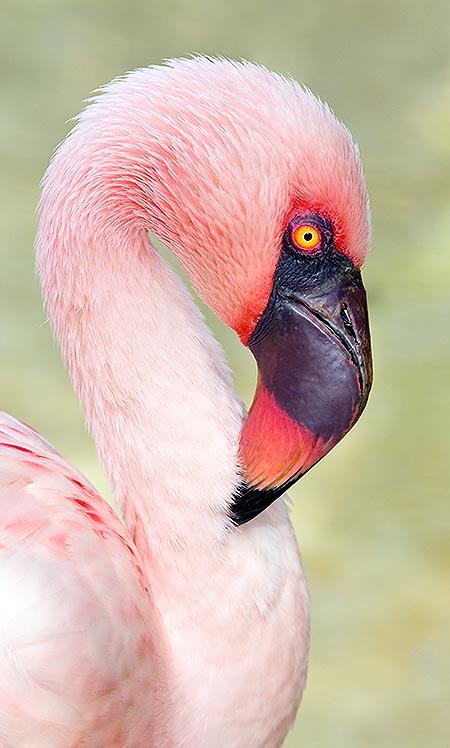
Phoenicopterus minor stocky beak is longer than the head © Giuseppe Mazza
In this regard, the Austrian ornithological biologist Max Furbringer created specifically, in 1758, a new order, that of the Phoenicopteriforms (Phoenicopteriformes), in order to be able to give them a systematic positioning.
Presently, the zoological classification of these wonderful birds is as follows: superorder of the Neorniths (Neornithes), order of the Phoenicopteriforms (Phoenicopteriformes), family of the Phoe- nicopterids (Phoenicopteridae), and genera Phoenicopterus, Phoenicoparrus and Phoeniconaias.
The bio-geographic and ecogeographical study on the distribution of these birds, the analysis of the biotopes where they live, their auto-ecology and synecology, is the criterion that has allowed the ornithological biologists to determine the various species of the group. But are however evident, in all the species of this order, some common general lines, for what concerns the animal behaviour and the ecology. Already from its scientific name they wanted to indicate a morphological characteristic concerning all the species included in this grouping. “Phoenicopterus” gets its origin from the Greek “phoinix” = red, carmine and “pteron” = wing, rightly, a characteristic common to all flamingoes.
The flamingos, generally speaking, live in the little deep waters of the lagoons, the ponds, the lakes and along the sea coasts, grouped in quite numerous colonies, which may include several thousands of individuals. Their alimentation exploits the particular characteristics of the beak, which renders these birds filtering organisms. In fact, they immerse it completely into the water and, moving continuously the head from left to right, rooting the muddy bottom, nourish of crustaceans (for instance, the Artemia salina in the very salty waters), of weeds and of molluscs.
If the alimentation consists of animals, after having placed the long neck perpendicularly to the water, they pass the upper part of the beak on the slimy bottom and move the layer of mud which is deposited there.
When the great beak is full of mud, and of the animals in it contained, the tongue, which before was retracted, is pushed ahead, for expelling, through particular filtering lamellae, the possible wastes.
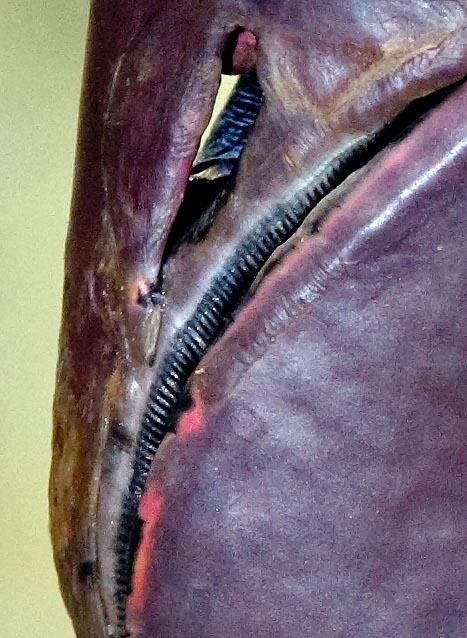
Details of the nares and the filtering lamellae of the beak © Giuseppe Mazza
This filtering action has further improved in the species which nourish mostly of weeds, and which, in this way, may assimilate the microscopic organic substance contained in the silt.
After having abundantly fed, the flamingos of all the species spend hours and hours during the digestion as well as during the sleep, assuming a classical and odd position, with the body supported by one only leg at the time, while the other is bent under the abdomen.
Periodically, the leg carrying the weight of the body is changed, utilizing that which has remained resting. The reason why these birds utilize such position for sleeping and during the digestion has aroused, for years, the curiosity of the zoological biologists.
Nowadays that have hypothesized that it is used for decreasing their temperature curve. In fact, they are birds living constantly in the water, element where the dispersion of the heat is very high. After a meal the temperature curve of the body already lowers due to physiological reasons, as most of the systemic blood in circle is sent to the digesting system for the digestion process, and two great webbed feet in the water would disperse too much heat.
Staying on only one leg at the time, allows therefore reducing this phenomenon during the digestion and the sleep. The regular change of leg, on which to rest the weight of the body, explains, on the contrary, with the fact that its legs are very long and little robust, and using always the same would be too tiring for the bird.
We have not to forget, moreover, that, being birds, the flamingos are endotherm-homeotherm animals and that the homeothermy keeps constant, thus reducing at the minimum level the heat dispersion. Same applies also for the endothermy. Other species of animals adopt, for this purpose, different strategies. The herbivorous mammals, for instance, increase the metabolic rate and utilize most of the metabolic energy introduced with the vegetables (please refer to Perissodactyla).
During the digestion and the rest, the neck of the flamingos is always bent laterally and backward, leaning on the back, while the head keeps half-hidden between the feathers.
In case of danger, these birds take off at the same time, initially moving slowly, then always faster till reaching the 60 km/h.
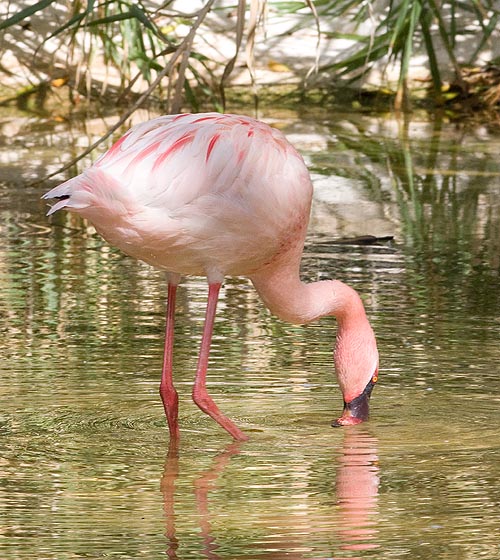
All flamingos spend most of the day rooting the muddy bottom © Giuseppe Mazza
Their most frequent foes, besides humans, are the lions, the cheetahs, the hyaenas, the vultures, the eagles and, unexpectedly, in Africa, some species of baboons.
The young are, of course, the easiest victims, and in fact only a rather small percentage of them may reach the maturity.
Presently, the ornithological biologists recognize five species of flamingos, the most known of which, often present in zoological gardens, zoo-safaris, but also in natural parks and public gardens, is the American Flamingo (Phoenicopterus ruber) which has two races: the Phoenicopterus ruber ruber and the Phoenicopterus ruber roseus.
However, many other ornithologists since time do consider these two subspecies as species themselves distinguishing the two specimens of American flamingo (Phoenicopterus ruber) and Greater flamingo (Phoenicopterus roseus), thus putting an end to long diatribes. The first lives in the Atlantic coast and in the islands of tropical and subtropical America. It differs from the nominal species because it has a livery almost completely of lobster pink colour. Conversely, the European Greater flamingo (Phoenicopterus ruber roseus) is diffused in the Mediterranean area and in the Ethiopian Africa, like the nominal species, the Pink flamingo (Phoenicopterus ruber).
In particular, this last nidifies at the mouths of the Rhone River and in some lagoons of southern Spain, in some sites of Italy as well as in Africa, in the Rift Valley.
The adult may reach the 1,30 m of length. It has a graceful appearance and a showy livery, where the white melts with the pink, the red with the crimson and the black. The legs are reddish; the beak is black at the apex.
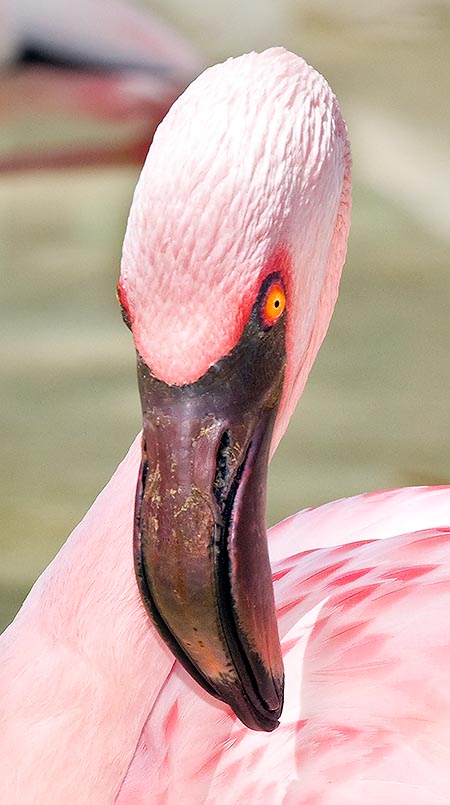
The beak upper part is clearly smaller © Giuseppe Mazza
Like the anatins, they place, during the flight, in a “V” formation, with the strongest and most resistant individuals ahead.
In the same diffusion areas, lives also the Lesser flamingo (Phoeniconaias minor), which, even if occupying the same ecologic niche of the pink flamingo, does not compete with this one for the food.
As a matter of fact, the Phoenicopterus ruber nourishes chiefly of crustaceans, the Phoeniconaias minor eats also microscopic algae.
As the name suggests, it is obviously smaller. It does not exceed, in fact, the 95 cm of length.
The plumage is on the whole more pinkish than in the European species Phoenicopterus ruber, and the black dot at the apex of the beak is small.
There is then a Chilean species, the Phoenicopterus chilensis, rather similar to the lesser flamingo.
Finally, we mention the genus Phoenicoparrus, little known by the neophytes.
The birds of this genus live in central and southern America. They differ from those of the previously mentioned species because they have three toes in the fingers instead of four.
This genus includes only two species, presently very rare and by now members of the IUCN “red list of the endangered species”. These are the Andean flamingo (Phoenicoparrus andinus) and the James’s flamingo (Phoenicoparrus jamesi).
As briefly said before, the flamingos are birds with an uncertain systematic collocation, as even the International Commission for Zoological Nomenclature (ICZN) points out.
Some ornithological biologists include them in the Ciconiiforms (Ciconiiformes), due to their appearance similar to waders, for the structure of some internal organs and also for the morphology and some anatomical characters of the thorax.
On the other hand, the structure of the beak, in particular of the lamellae of filtration, the webbed feet, the voice and the cries they emit, plus some habits of the chicks, lead other zoological biologists to approach them to the order of the Anseriforms (Anseriformes).
The oddest and most impressive thing is the look these birds in all genera and relevant species do have. Their body has a really elegant and slender shape, which reminds that of the swans.
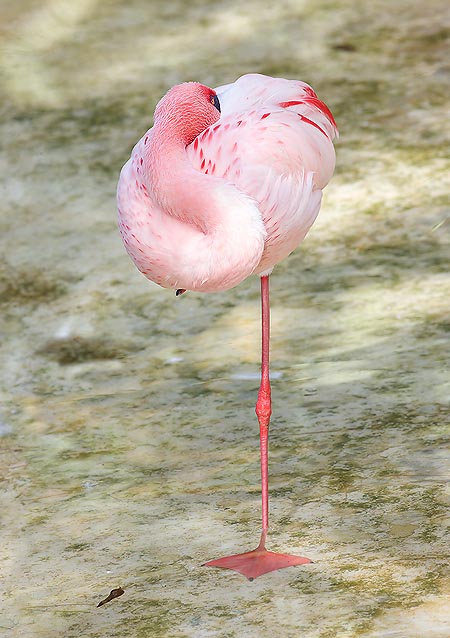
Flamingos reduce the heat dispersion standing on one leg only © G. Mazza
As a contribution to render harmonious the whole, stands the shape of the neck, exceptionally long and mobile, supporting a head rather big, equipped with that characteristic and great beak.
This has two branches clearly distinct: the upper one is small whilst the lower one is much developed.
By about mid of its length, the beak bends downwards with a sharp curve; it is very big and stocky and exceeds the head in length.
Both branches edges are equipped of several corneous lamellae, horizontally and transversally placed.
These lamellae, typical of the anseriforms, operate as a filter, and represent a case of eco-evolutionary convergence between two different orders.
Almost all the external surface of the beak is covered by a membrane and whilst the apex is particularly hard and resistant, the room between the two branches in the basal portion is occupied by a waxy and soft substance.
The lower jaw is fixed whilst the upper one is mobile. The nares open on the skull, before the base of the beak. The inner cavity of the beak is occupied by a large, fleshy tongue that fills in perfectly the space.
The wings, not particularly developed, have 11 primary remiges, the first of which is the longest. And this is the one being cut when the animal is in captivity, without causing any pain to the animal, in order it takes off and escapes.
The secondary remiges are all longer than the primaries. The tail is small and blunt, with 12-16 rectrices.
The legs are very long, similar to much thin stilts. The tibia is bare, whilst the tarsus is covered by ample corneous shields.
There are four toes per foot: the front three are united by an inter-digital membrane which has light indents. The back toe, which in the genus Phoenicoparrus is missing at all, is free and very small. An impressive particular, in the various species, is the colour of the plumage, as partially already said, which appears compact and with abundant quilt.
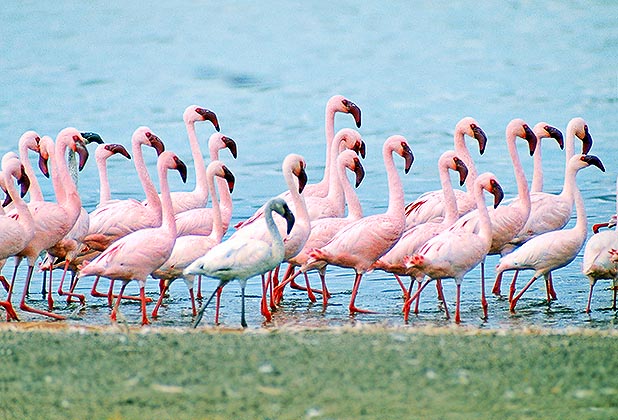
A group pf phoenicopterus minor along the shores of Nakuru Lake in Kenya © Giuseppe Mazza
The feathers of the wings are black or deep pink.
The flamingos of the various species have only one annual moulting, during which they lose also the rectrices and therefore, for a certain time they are unable to fly, thus becoming more vulnerable to the predators.
The structure of the skeleton has some interesting characteristics: the cervical vertebrae are thin, long and quite complex, the fourchette or furcula is U-shaped, the sternum is poorly keeled and the tibia is very long, if compared to that of any other bird.
Incidentally, the “pectoral girdle” is formed on each side of the scapula, the coracoid, and the clavicle is united to that of the other side thus forming the aforementioned fourchette or furcula.
The capacity these birds have to live, nourish and reproduce in salty aquatic habitats, such as the marine coastal ones, or in salty lakes and lagoons as well as in Mangrove areas is guaranteed by the existence of “salt glands” with which they expel the excess of salt assumed during the nutrition.
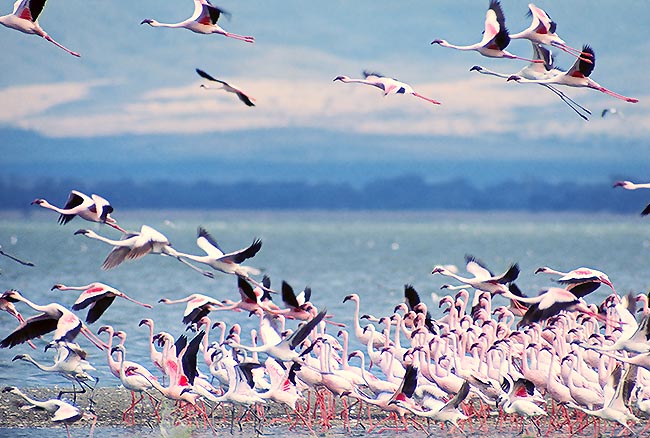
In case of danger the flamingos take off all together © Giuseppe Mazza
At the beginning these are much staid, but later on, going ahead, they become increasingly disordered.
During such exhibition, the males rightly exhibit the wonderful colours of their livery, emitting, unceasingly, very high cries.
In the little deep waters (fresh as well as salt), close to the beaches, they build a nest with a very particular form.
It has the shape of a truncated cone, with the lower base of 40-60 cm of diameter and a height varying from 10 to 50 cm, carrying on the top a recess where the eggs are lodged.
For building it, the flamingos utilize mud from the bottom, mixed with bones and vegetal residuals, which, once kneaded, dries up and hardens. The nests are built very close to each other and their presence grants the lagoon a particular look. During the gestation and the hatching, the flamingos lose the gregarious instinct and tend to maintain the pair; furthermore, even if the nests are so much near, there is an, even if approximate, delimitation of the territory.
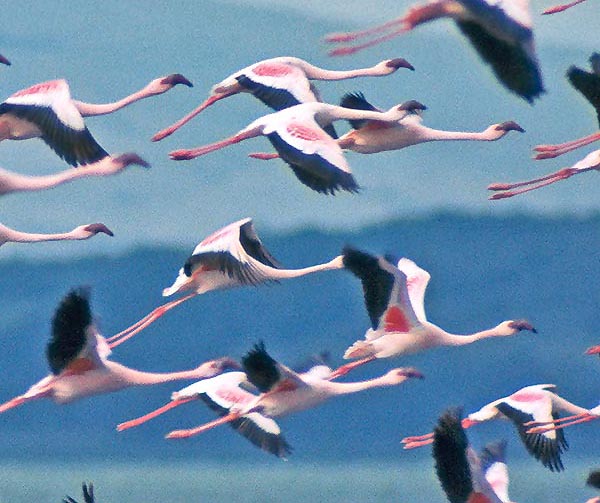
These Phoenicopterus minor may reach the 60 km/h © Giuseppe Mazza
By the deposition, the shell of the egg is covered by a calcareous concentration, which gets off almost immediately.
The deposition happens at the same time for the whole colony, because these birds mate all of them in a very short period and also because possible pairs formed late, become nervous and excited by seeing the newborn and give up the clutch.
The incubation lasts 28-32 days and both parents take care of it.
Once, they thought that for hatching the flamingos placed astride on the nest, but the ornithological biologists, from recent observations, have ascertained that they fold up the legs under the body, exactly as all other birds do.
The chicks come to life covered by a greyish down; have short legs and straight beak. In the whole, they fairly resemble to the chicks of the anseriforms.
For about one month, they are nourished by the parents by means of a crop milk secreted by oesophageal glands. Since the first week of post-natal life, they are able to get out from the nest and to swim easily. During their displacements, they move always in compact groups, formed even by hundreds and hundreds of units.
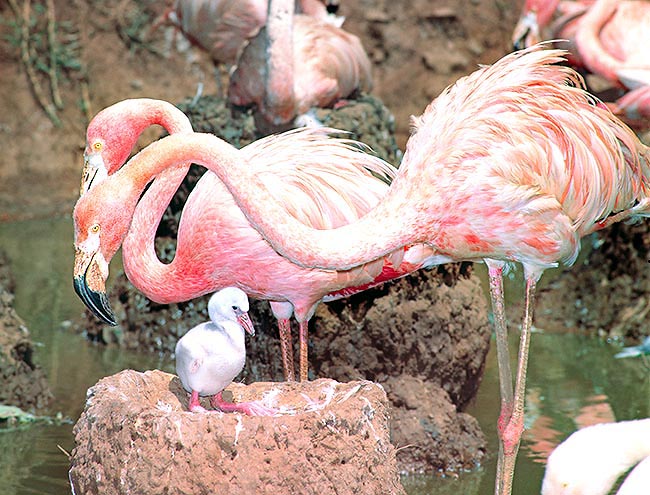
A pair of Phoenicopterus ruber with chick, close to the nest © Giuseppe Mazza
The plumage of the sub-adults is the same as the adults and does not differ between males and females, therefore a sexual dimorphism, whatever seasonal or permanent, is absent, for what the plumage is concerned. The pink and red colouration is caused by the assumption in the diet, of crustaceans, whose exoskeletons contain pink-red pigments which deposit in the plumes and the feathers of the bird.
In captivity, when the humid zone where they are kept is devoid of these crustaceans, their plumage “eclipses”, turning to the pale grey. But when furnishing with the artificial diet such organisms, their livery will be again bright and coloured as in the wild.
